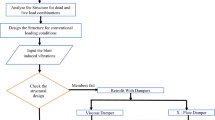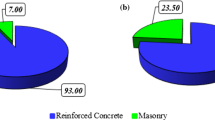Abstract
The presented results and discussion concern the behavior of a steel rectangular profile which can be found at the building entrances exposed to blast effect of military explosives. Currently, high explosives with liners are used to create armour-piercing charges to increase their effect. The article deals with the possible use of standardized TNT block demolition charges used in military practice to create improvised shaped charges to increase their penetrating effect in comparison with the concentrated or linear charges usually generated from this block demolition charges. The advantage of using the tested block demolition charges is their lower acquisition value in comparison with a special demolition charges and the speed of assembly of improvised shaped charges in field conditions. Several shaped charge types of different shapes have been designed. In the representative samples of designed shaped charge types, their effect on a structural element occurring was simulated, whereas the effect of explosive flow was further compared in these cases with simulations in the ANSYS software. The experiment performed in a live blasting area presented the effect of all charge types. The aim of the article was to verify the different effect of individual charge types on the structural element and to assess their penetrating properties. The results enable the determination of the further course of research in this area.
Access this chapter
Tax calculation will be finalised at checkout
Purchases are for personal use only
Similar content being viewed by others
References
Kyjovský, J., Kroupa, L.: Bojová ženijní podpora. Jednoduché trhací práce. 1st edn., pp. 12–18. University of Defence, Brno (2017)
Zukas, J.A., Walters, W.: Explosive Effects and Application. Springer, New York (1998). https://doi.org/10.1007/978-1-4612-0589-0
Jangl, Š., Kavický, V. Ochrana pred účinkami výbuchov výbusnín a nástražných výbušných systémov. 1st edn. Jana Kavická-KAVICKY, Oščadnica (2012)
Stanković, S., Škrlec V., Dobrilović M., Bohanek V.: Velocity of detonation of AN base blasting agent with addition of hay and recycled rubber. In: Proceedings of the 21th Seminar on New Trends in Research of Energetic Materials, pp. 1042–1050. Springer, Pardubice (2018)
Caçoilo, A., Mourão, R., Belkassem, B., Teixeira-Dias, F., Vantomme, J., Lecompte, D.: Blast wave assessment in a compound survival container: small-scale testing. In: The 18th International Conference on Experimental Mechanics. MDPI, Basel (2018)
Smith, P.: Blast walls for structural protection against high explosive threats: a review. Int. J. Protect. Struct. 1(1), 67–84 (2010)
Hajek, R., Foglar, M., Fládr, J.: Influence of barrier material and barrier shape on blast wave mitigation. Constr. Build. Mater. 120, 54–64 (2016)
Zezulová, E., Hasilová, K., Komárková, T., Stoniš, P., Štoller, J., Anton, O.: NDT methods suitable for evaluation the condition of military fortification construction in the field. Appl. Sci. 10(22), 8161 (2020)
Caçoilo, A., Teixeira-Dias, F., Mourão, R., Belkassem, B., Vantomme, J., Lecompte, D.: Blast wave propagation in survival shelters: experimental analysis and numerical modelling. Shock Waves 28(6), 1169–1183 (2018). https://doi.org/10.1007/s00193-018-0858-5
Malhotra, A., Carson, D., McFadden, S.: Blast pressure leakage into buildings and effects on humans. Proc. Eng. 210, 386–392 (2017)
Karlos, V., Solomos, G., Larcher, M.: Analysis of the blast wave decay coefficient using the Kingery-Bulmash data. Int. J. Protect. Struct. 7(3), 409–429 (2016)
Figuli, L., Bedon, C., Zvaková, Z., Jangl, Š, Kavický, V.: Dynamic analysis of a blast loaded steel structure. Proc. Eng. 199, 2463–2469 (2017)
Cormie, D., Mays, G., Smiths, P.: Blast Effects on Buildings, 3rd edn. ICE Publishing, London (2019)
Shin, J., Whittaker, S.A., Cormie, D., Wilkinson, W.: Numerical modeling of close-in detonations of high explosives. Eng. Struct. 81, 88–97 (2014)
Štoller, J., Dvořák, P.: Field tests of cementitious composites suitable for protective structures and critical infrastructure. Key Eng. Mater. 722, 3–11 (2016)
Štoller, J., Dvořák, P.: Reinforced concrete frames under distant blast. Key Eng. Mater. 755, 229–235 (2017)
Hájek, R., Fládr, J., Pachmáň, J., Štoller, J., Foglar, M.: An experimental evaluation of the blast resistance of heterogeneous concrete based composite bridge decks. Eng. Struct. 179, 204–210 (2019)
Alogla, A., Helal, M., ElShafey, M.M., Fathallah, E.: Numerical analysis for critical structures protection against blast loading using metallic panels. Appl. Sci. 10(6), 2121 (2020)
Guerrero, A.J., Sánchez, P.J., Dias, T.F.: Blast wave dynamics: the influence of the shape of the explosive. J. Hazard. Mater. 331, 189–199 (2017)
Guo, H., Zheng, Y., Yu, Q., Ge, C., Wang, H.: Penetration behavior of reactive liner shaped charge jet impacting thick steel plates. Int. J. Impact Eng. 126, 76–84 (2019)
Hryciów, Z., Borkowski, W., Rybak, P., Wysocki, J.: Influence of the shape of the explosive charge on blast profile. J. KONES Powertrain Transp. 21(4), 169–176 (2014)
Acknowledgment
This research was funded by the Ministry of Defence of the Czech Republic, grant LANDOPS “Conduct of Land Operations” and by the Ministry of Education, Youth and Sports of the Czech Republic under specific research grant.
Author information
Authors and Affiliations
Corresponding author
Editor information
Editors and Affiliations
Rights and permissions
Copyright information
© 2023 The Author(s), under exclusive license to Springer Nature Switzerland AG
About this paper
Cite this paper
Palasiewicz, T., Rolenec, O., Kroupa, L., Maňas, P., Coufal, D. (2023). Blast-Induced Deformations of the Building Entrance Part Caused by Improvised Shaped Charges. In: Mazal, J., et al. Modelling and Simulation for Autonomous Systems. MESAS 2022. Lecture Notes in Computer Science, vol 13866. Springer, Cham. https://doi.org/10.1007/978-3-031-31268-7_7
Download citation
DOI: https://doi.org/10.1007/978-3-031-31268-7_7
Published:
Publisher Name: Springer, Cham
Print ISBN: 978-3-031-31267-0
Online ISBN: 978-3-031-31268-7
eBook Packages: Computer ScienceComputer Science (R0)




